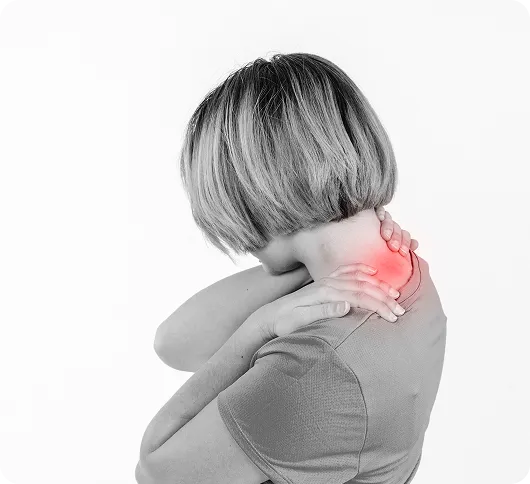Cervical Facet Joint Arthritis Relief
Minimally invasive care to reduce pain and improve neck mobility

What Is Cervical Facet Joint Arthritis?
Cervical facet joint arthritis is a degenerative condition that affects the joints in the cervical spine near the neck.
As cartilage breaks down, the bones begin to rub against each other, leading to symptoms such as stiffness, neck pain, and headaches. As the condition progresses, it can irritate nerves-including the sciatic nerve-causing radiating pain from the neck down to the lower back and even into the legs. This overlap in symptoms makes it important to distinguish between sciatica and cervical facet joint arthritis, as treatment approaches may differ.
A professional evaluation is key to identifying the condition accurately and creating an effective treatment plan.
What Is Cervical Facet Joint Arthritis?
Cervical facet joint arthritis is a degenerative condition that affects the joints in the cervical spine near the neck.
As cartilage breaks down, the bones begin to rub against each other, leading to symptoms such as stiffness, neck pain, and headaches. As the condition progresses, it can irritate nerves-including the sciatic nerve-causing radiating pain from the neck down to the lower back and even into the legs. This overlap in symptoms makes it important to distinguish between sciatica and cervical facet joint arthritis, as treatment approaches may differ.
A professional evaluation is key to identifying the condition accurately and creating an effective treatment plan.

Causes and Risk Factors
Cervical facet joint arthritis is usually related to aging. However, external factors like a physical injury or bad posture could also increase the risk of developing cervical facet joint arthritis. Some of the most common causes of this condition include the following:
Trauma or injury to the neck: Physical damage from a workplace injury or car accident could be the root cause of cervical facet joint arthritis.
Degenerative changes in the cervical spine: Aging causes wear in the spine, leading to the breakage of cartilage.
Obesity: Excess weight could potentially increase the risk of developing cervical facet joint arthritis since extra stress on the lumbar area accelerates wear.
Poor posture: When sitting or standing in the wrong position, your cervical spine could become damaged and develop arthritis.
Symptoms of Cervical Facet Joint Arthritis
This condition may cause a variety of symptoms, such as:
✔ Dull, aching pain in the neck, shoulders, and upper back
✔ Stiffness and reduced range of motion in the neck
✔ Tenderness near the affected joints
✔ Frequent headaches
Diagnosis
Accurate diagnosis involves several steps:
Family history evaluation: Some degenerative conditions may have a genetic component.
Physical examination: If no hereditary link is found, your doctor will examine your cervical spine and upper back.
Imaging studies: X-rays, MRIs, or CT scans help detect damage that may not be visible during the physical exam.
Diagnostic nerve blocks: These injections temporarily numb targeted nerves to confirm the pain source.
Treatment Options for Cervical Facet Joint Arthritis
As cervical facet joint arthritis is a degenerative condition, treatments focus on stopping its progression and restoring your spinal health. To achieve this, your doctor may choose from the following procedures:
Conservative Therapies
Conservative therapies are procedures that use multiple exercises or healthcare techniques to alleviate pain symptoms without disrupting your nerves.
Using these kinds of treatments along with non-opioid medications or minimally invasive interventions is suggested. Options include:
✔ Massage therapy
✔ Acupuncture
✔ Chiropractic care
Lifestyle Changes
Certain lifestyle adjustments may help manage symptoms and slow degeneration:
✔ Performing low-impact exercises to strengthen the muscles around the spine and add flexibility to the lumbar area.
✔ Having a balanced diet and healthy lifestyle to manage weight and reduce lumbar stress.
✔ Using ergonomic chairs improves posture and reduces pressure and pain in your spine.
Non-Opioid Medications
Non-opioid medications are preferred for their effectiveness and lower risk of side effects or dependency. These include:
✔ Nonsteroidal anti-inflammatory drugs (NSAIDs)
✔ Muscle relaxants
These medications can be used alone or alongside other therapies such as physical therapy.
Injections
Unlike local anesthetics, injections offer longer-lasting relief for patients dealing with cervical facet joint arthritis. Steroid injections, for example, are injected near the spinal nerve area, stopping the transmission of pain signals to the brain. Facet joint injections, on the other hand, are targeted into the joints on the vertebra that could be causing nerve compression.
Pain Management Procedures
These treatments focus on blocking pain signals before they reach the brain. When paired with therapy, they can improve quality of life significantly.
✔ Medial branch blocks: Involves injecting anesthetic near the medial branch nerves to identify or relieve the source of pain.
✔ Radiofrequency ablation: Uses heat to disrupt irritated nerve activity, providing longer-term relief.
Neuromodulation
Neuromodulation can help reduce the lumbar stress caused by cervical facet joint arthritis by using nerve stimulation. Some of these treatments include the following options:
✔ Spinal cord stimulation is a treatment that uses electrical impulses to modify the nerve activity in the spine. As the nerve signals become blocked by this stimulation, the pain won’t be felt even though the symptom source remains.
Minimally Invasive Interventions
One of the most effective minimally invasive options is cryoneurolysis, which uses cold temperatures to disrupt pain signal transmission:
✔ A device called a cryoprobe is inserted near the problematic nerve and freezes it to interrupt pain pathways.
✔ This method avoids traditional surgery, reducing recovery time and minimizing complications while improving mobility and reducing discomfort.

Care That’s Close to Home
We offer care from two convenient clinic locations, making it easy to access expert medical support close to home.
Each facility is designed to provide a welcoming, safe, and efficient environment equipped with advanced technology and supported by a compassionate team dedicated to your well being.
Care That’s Close to Home
We offer care from two convenient clinic locations, making it easy to access expert medical support close to home.
Each facility is designed to provide a welcoming, safe, and efficient environment equipped with advanced technology and supported by a compassionate team dedicated to your well being.

Why Choose Spinal Diagnostics?
Patients choose Spinal Diagnostics for our comprehensive approach, accurate diagnostics, and compassionate care. We stay at the forefront of interventional procedures and are committed to improving your quality of life without opioids or invasive surgeries.
Proven Medical Expertise
We bring years of clinical experience in pain management and interventional procedures.
Constant Innovation
We use the latest techniques and technology to ensure safe, effective treatment.
Compassionate Care
We listen, understand, and treat every patient with empathy and respect.
Personalized Plans
Each treatment is tailored to your condition, goals, and lifestyle.
Explore the treatments that bring real relief.
Learn how our non-invasive solutions and personalized plans can help you feel better, faster.
Explore the treatments that bring real relief.
Learn how our non-invasive solutions and personalized plans can help you feel better, faster.


